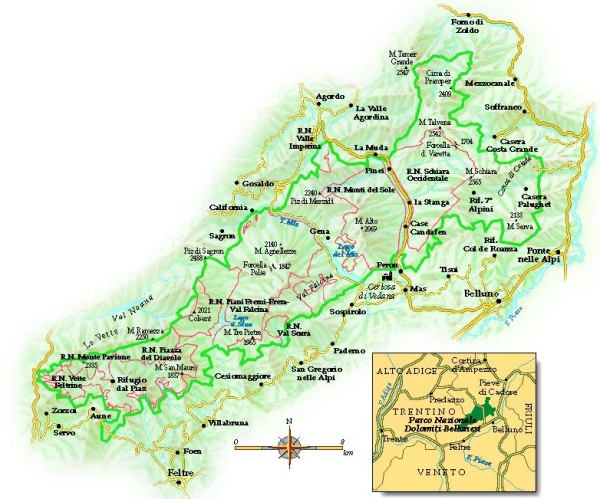 |
|
THE NATIONAL PARK OF THE DOLOMITES
CHARACTERISTICS OF THE TERRITORY
The National Park of the Dolomites around Belluno was created to protect a territory of extraordinary value as regards landscape and nature. The "Vette of Feltre" and Mouth Serva have been very famous because of their flora since the XVII century. The presence of rare species and an exceptional variety of environments is due to the geographic location of the Park. The territory of the Park includes environments of medium and high altiudine,which are very scarcely populated.
The most remarkable areas for nature are in the highest zones, in the uplands and in the "Buse" of glacial origin. The main characteristic of the Park is the great variety of habitants and landscapes, which are particularly appreciable during summertime when flowers bloom.
The "Monti del Sole " are the wild heart of the Park: they are magnificent and almost inaccessible.
After a first provisional perimetrical analysis in 1990, National Park of the Dolomites round Belluno was instituted in 1993. The Park covers an area of 32 thousand hectares, half of which were already included in eight state-controlled nature reserves. Different environments and cultures coexist in the Park area. The Park is entirely located in the Veneto Region and in the province of Belluno.
HISTORY
Human settlement in the territory of the National Park of the Dolomites round Belluno and province has a very ancient origin, in contradiction whit the present situation of apparent abandonment. Recent archaeological excavations have displayed very old traces of human settlement.
In the course of the past centuries the mountains has been the centre of agricultural, pastoral and forest activities, which developed most during the XVII century. To testify these activities, there is nowadays an important net of architectonic structures of rural type, which deserve to be maintained.
The territory of the Park is extremely varied and interesting both at structures and stratigraphic levels.
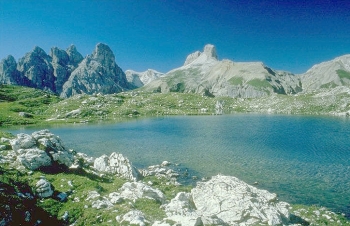 Among
the latter, a much deeper sea furrow developed, the Belluno basin, in
which sediments, rich in marly and flint components, deposited.
Among
the latter, a much deeper sea furrow developed, the Belluno basin, in
which sediments, rich in marly and flint components, deposited.
Nowadays, these components make up a wide range of lithological formations. A great part of the territory consist of sedimentary rocks. There are however some exceptions, as in the upper Mis valley and in the Imperina valley, where rocks of metamorphic origin , constituting the crystalline basis of the Alps, crop out. In the same area other rocks of the Permian age emerge.
The Park also boasts remarkable geo-morphical phenomena. There are splendid examples of glacial phenomena in the "buse" round Feltre and in the varius "van" round Belluno. The Karst morphology is also very well represented.
VEGETATION
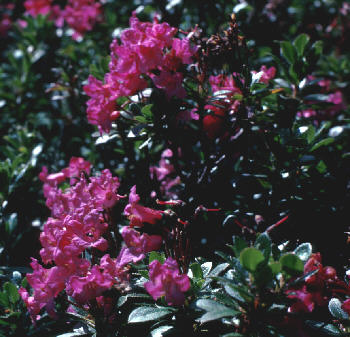 Within
the National Park of the Dolomites round Belluno, vegetation is represented
by different levels of altitude. The Middle European level has environments
that have been often transformed by human action. Its main feature are
copses, mainly hornbeams and oaks. Dry and rocky sites located on sunny
slopes and humid and shadowy gorge environments are all places of remarkable
natural richness. The dry mountain prairies also constitute an element
of particular value: they have replaced the woods that formerly covered
the southern sides of the Park and are presently rich in rare species.
The alpine level is that of greatest botanic interest. It has primary
pastures hosting different types of vegetal communities: sessleria,
nards,fescues and sedges.
Within
the National Park of the Dolomites round Belluno, vegetation is represented
by different levels of altitude. The Middle European level has environments
that have been often transformed by human action. Its main feature are
copses, mainly hornbeams and oaks. Dry and rocky sites located on sunny
slopes and humid and shadowy gorge environments are all places of remarkable
natural richness. The dry mountain prairies also constitute an element
of particular value: they have replaced the woods that formerly covered
the southern sides of the Park and are presently rich in rare species.
The alpine level is that of greatest botanic interest. It has primary
pastures hosting different types of vegetal communities: sessleria,
nards,fescues and sedges.
FAUNA
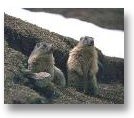
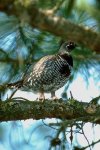 Among
the mammals, the most significant species are the ungulates, among which
the chamois, the roe-deer and the deer stand out. In the Park there
is also the mouflon, which was imprudently introduced for hunting purposes.
Practically all the other species of alpine fauna are present:the alpine
hare, the fox, the badger, the ermine, the weasel, the marten,the beech-marten,the
squirrel,the loirand the hedgehog.
Among
the mammals, the most significant species are the ungulates, among which
the chamois, the roe-deer and the deer stand out. In the Park there
is also the mouflon, which was imprudently introduced for hunting purposes.
Practically all the other species of alpine fauna are present:the alpine
hare, the fox, the badger, the ermine, the weasel, the marten,the beech-marten,the
squirrel,the loirand the hedgehog.
Authors: Eleonora |
Around Venice |
Venise et ses alentours |
Home page Site |
